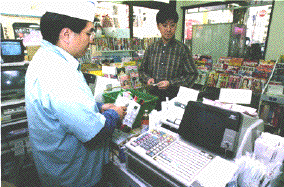
Konbini are playing an increasing role in modern Japanese life. (Photo: Kyodo)
CONVENIENCE STORES:
Their Upside and Downside
March 25, 1997

Konbini are playing an increasing role in modern Japanese life. (Photo: Kyodo)
Convenience stores (or konbini, as the Japanese call them) have existed in Japan for over 20 years now. With convenience as their stock in trade, these shops--of which the country now has over 50,000--have become firmly entrenched in people's everyday lives. But they have also drawn criticism for what many people see as their negative impacts, including noise and exhaust fumes from delivery trucks and the departure of the established merchants that give neighborhoods their character. Despite their many advantages, convenience stores also have a downside.
Outshining Their American Counterparts
Japan's first konbini, open late into the night and offering everything from foods to everyday personal and household items, appeared in 1974. It was the first store in a franchise established by a U.S.-based convenience store franchiser in partnership with a major Japanese supermarket chain. Doubling and redoubling with each passing year, the konbini franchise had grown to over 2,000 stores by 1983, its tenth year of existence. It now boasts a 6,500-store empire. This mighty forerunner of all konbini bought out its U.S. parent in 1990 and is now operating successfully under its new management.
Other companies have since entered the convenience-store business, and 50,000 konbini are now jostling each other in the Japanese market. In Japan, there are now twice as many convenience stores as there are post offices, and about as many as there are gas stations. Konbini carry an average of 3,000 products, and their total annual sales figure of 7 trillion yen (56 billion dollars at 125 yen to the dollar) is nearly on a par with the total sales of the country's department stores and almost half of total supermarket sales. And the number of konbini is still growing by over 1,000 every year.
The main factor behind convenience stores' meteoric rise to success is their business hours: late into the night (or even around the clock), seven days a week, 365 days a year. Konbini are well-suited to an era in which a growing segment of the population--salaried workers, students, and others--sees the need for stores that stay open late. Another reason for the success of konbini is that the stores were quick to begin using point-of-sales systems, which give them ready access to data on shifts in sales trends so they can act right away to lay in the goods customers want. There is also the wide range of goods and services they provide, from selling fast food to acting as agents for parcel delivery services.
Service and Customer-Range Expansion
In recent years, convenience stores have seen their customer base widen dramatically. In a 1985 survey carried out by a major chain, the number of single konbini customers was more than double the number that were married. By 1995, however, these percentages had roughly equalized.
Konbini are appealing to a wider customer group because they are offering a more diverse range of goods and services. Some konbini serve as outlets for stamps and postcards, floral delivery serives, pagers, airline and movie tickets, and even ski lift tickets. At some stores, it's not only possible to make a copy or send a fax, but also to apply for cable TV service. Many konbini accept payments for electric, gas, and water bills, and some even have cash dispensers. It's getting so that people can take care of all their errands in one stop, with no need to go to a supermarket for food, the post office for stamps, a travel agency or airport for airline tickets, and so on.
In an effort to draw even more customers, new types of convenience stores are constantly arriving on the scene. There are konbini combined with public baths or tennis courts, konbini inside train stations and hotels, konbini on college campuses, and konbini that have no clerks because they dispense all their goods and services through vending machines.
Negative Aspects Also Seen
But these one-stop wonders also have their downside. In many communities, the arrival of konbini has wiped out the distinctive neighborhood landscape by forcing mom-and-pop operations and other smaller businesses to close their doors.
Another problem has to do with the fact that convenience stores by their very nature have almost no space for storing inventory. Instead, goods are delivered by truck from a centrally located depot. Competition among convenience stores has reached a fevered pitch, and the success of a konbini rests on its ability to lay in the freshest goods possible in the shortest amount of time. The inevitable result has been the emergence of "just-in-time" practices involving frequent deliveries and small batches. One chain even uses a global positioning system to monitor truck positions and track delivery times down to the minute. Under these just-in-time practices, trucks arrive at the stores several times a day. The exhaust fumes from the trucks, and the noise from unloading the deliveries, have an adverse impact on neighborhood environments.
One of the biggest-selling items at konbini is boxed meals. According to one major konbini chain, 18- to 24-year-old single people eat an average of more than three boxed meals from konbini each week. One convenience store has even been heard to boast that the time is coming when households will no longer need their own refrigerators, cutting boards, knives, or pots. There are some people who fear that the distinctive quality of the home is being exchanged for convenience, and that the spread of konbini is diluting traditional culture.
| MOFA Home Page | JIN Home Page |